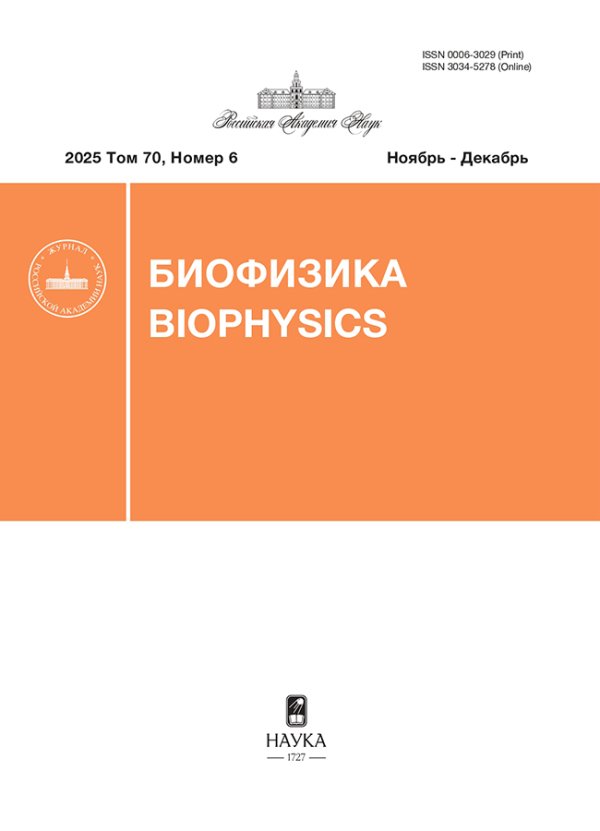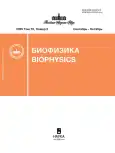Features of Smooth Muscle Cells of the Thoracic Aorta of SHR Rats in the Early Stages of Arterial Hypertension
- Authors: Zhalimov V.K1, Meshcheryakova E.I1, Vikhlyantsev I.M1,2, Gritsyna Y.V1
-
Affiliations:
- Institute of Theoretical and Experimental Biophysics, Russian Academy of Sciences
- Pushchino branch of the Russian Biotechnological University (BIOTECH University)
- Issue: Vol 70, No 5 (2025)
- Pages: 913-922
- Section: Cell biophysics
- URL: https://journal-vniispk.ru/0006-3029/article/view/348532
- DOI: https://doi.org/10.31857/S0006302925050078
- ID: 348532
Cite item
Abstract
About the authors
V. K Zhalimov
Institute of Theoretical and Experimental Biophysics, Russian Academy of SciencesPushchino, Russia
E. I Meshcheryakova
Institute of Theoretical and Experimental Biophysics, Russian Academy of SciencesPushchino, Russia
I. M Vikhlyantsev
Institute of Theoretical and Experimental Biophysics, Russian Academy of Sciences; Pushchino branch of the Russian Biotechnological University (BIOTECH University)Pushchino, Russia; Pushchino, Russia
Yu. V Gritsyna
Institute of Theoretical and Experimental Biophysics, Russian Academy of Sciences
Email: gr123.86@mail.ru
Pushchino, Russia
References
- Frismantiene A., Philippova M., Erne P., and Resink T. J. Smooth muscle cell-driven vascular diseases and molecular mechanisms of VSMC plasticity. Cell Signal., 52, 48–64 (2018). doi: 10.1016/j.cellsig.2018.08.019
- Patel R. S., Masi S., and Taddei S. Understanding the role of genetics in hypertension. Eur. Heart J., 38 (29), 2309–2312 (2017). doi: 10.1093/eurheartj/ehx273
- Poulter N. R., Prabhakaran D., and Caulfield M. Hypertension. Lancet, 386 (9995), 801–812 (2015). doi: 10.1016/S0140-6736(14)61468-9
- Hopkins P. N. and Hunt S. C. Genetics of hypertension. Genet Med., 5 (6), 413–429 (2003). doi: 10.1097/01.gim.0000096375.88710.a6
- Global atlas on cardiovascular disease prevention and control. Ed. by S. Mendis, P. Puska, and B. Norrving (World Health Organization, Geneva, 2011).
- Tang H. Y., Chen A. Q., Zhang H., Gao X. F., Kong X. Q., and Zhang J. J. Vascular smooth muscle cells phenotypic switching in cardiovascular diseases. Cells, 11 (24), 4060 (2022). doi: 10.3390/cells11244060
- Martinez-Quinones P., McCarthy C. G., Watts S. W., Klee N. S., Komic A., Calmasini F. B., Priviero F., Warner A., Chenghao Y., and Wenceslau C. F. Hypertension induced morphological and physiological changes in cells of the arterial wall. Am. J. Hypertens., 31 (10), 1067–1078 (2018). doi: 10.1093/ajh/hpy083
- Frohlich E. D., Apstein C., Chobanian A. V., Devereux R. B., Dustan H. P., Dzau V., Fauad-Tarazi F., Horan M. J., Marcus M., and Massie B. The heart in hypertension. N. Engl. J. Med., 327, 998–1008 (1992). doi: 10.1056/NEJM199210013271406
- Rakugi H., Yu H., Kamitani A., Nakamura Y., Ohishi M., Kamide K., Nakata Y., Takami S., Higaki J., and Ogihara T. Links between hypertension and myocardial infarction. Am. Heart J., 132 (1), Pt 2 Suy, 213–221 (1996).
- Alexander R. W. Theodore Cooper Memorial Lecture. Hypertension and the pathogenesis of atherosclerosis. Oxidative stress and the mediation of arterial inflammatory response: a new perspective. Hypertension, 25 (2), 155–161 (1995). doi: 10.1161/01.hyp.25.2.155
- Droste D. W., Ritter M. A., Dittrich R., Heidenreich S., Wichter T., Freund M., and Ringelstein E. B. Arterial hypertension and ischaemic stroke. Acta Neurol. Scand., 107 (4), 241–251 (2003). doi: 10.1034/j.1600-0404.2003.00098.x
- Lattanzi S., Brigo F., and Silvestrini M.. Managing blood pressure in acute intracerebral hemorrhage. J. Clin. Hypertens. (Greenwich), 21 (9), 1332–1334 (2019). doi: 10.1111/jch.13627
- Dandapani B. K., Suzuki S., Kelley R. E., Reyes-Iglesias Y., and Duncan R. C. Relation between blood pressure and outcome in intracerebral hemorrhage. Stroke, 26 (1), 21–24 (1995). doi: 10.1161/01.str.26.1.21
- Pinto Y. M., Paul M., and Ganten D. Lessons from rat models of hypertension: from Goldblatt to genetic engineering. Cardiovasc Res., 39 (1), 77–88 (1998). doi: 10.1016/s0008-6363(98)00077-7
- Martinez-Quinones P., McCarthy C. G., Watts S. W., Klee N. S., Komic A., Calmasini F. B., Priviero F., Warner A., Chenghao Y., and Wenceslau C. F. Hypertension Induced Morphological and Physiological Changes in Cells of the Arterial Wall. Am. J. Hypertens., 31 (10), 1067–1078 (2018). doi: 10.1093/ajh/hpy083
- Mancusi C., Basile C., Fucile I., Palombo C., Lembo M., Buso G., Agabiti-Rosei C., Visco V., Gigante A., Tocci G., Maloberti A., Tognola C., Pucci G., Curcio R., Cicco S., Piani F., Marozzi M. S., Milan A., Leone D., Cogliati C., Schiavon R., Salvetti M., Ciccarelli M., De Luca N., Volpe M., and Muesson M. L. Aortic remodeling in patients with arterial hypertension: Pathophysiological mechanisms, therapeutic interventions and preventive strategies—A position paper from the Heart and Hypertension Working Group of the Italian Society of Hypertension. High Blood Press. Cardiovasc. Prev., 32 (3), 255–273 (2025). doi: 10.1007/s40292-025-00710-3
- Milan A., Tosello F., Naso D., Avenatti E., Leone D., Magnino C., and Veglio F. Ascending aortic dilatation, arterial stiffness and cardiac organ damage in essential hypertension. J. Hypertens., 31 (1), 109–116 (2013). doi: 10.1097/HJH.0b013e32835a0588
- Hu Y., Cai Zh., and He B. Smooth muscle heterogeneity and plasticity in health and aortic aneurysmal disease. Int. J. Mol. Sci., 24 (14), 11701 (2023). doi: 10.3390/ijms241411701
- Augoustides J. G. and Cheung A. T. Aneurysms and dissections. In: Perioperative Transesophageal Echocardiography. Ed. by D. L. Reich and G. W. Fischer (2014), pp. 191–217. doi: 10.1016/B978-1-4557-0761-4.00019-0
- Cao G., Xuan X., Hu J., Zhang R., Jin H., and Dong H. How vascular smooth muscle cell phenotype switching contributes to vascular disease. Cell Commun. Signal., 20 (1), 180 (2022). doi: 10.1186/s12964-022-00993-2
- Saito H., Hayashi H., Ueda T., Mine T., and Kunita S. I. Changes in aortic wall thickness at a site of entry tear on computed tomography before development of acute aortic dissection. Ann. Vasc. Dis., 12 (3), 379–384 (2019). doi: 10.3400/avd.oa.19-00051
- Rombouts K. B., van Merrienboer T. A. R., Ket J. C. F., Bogunovic N., van der Velden J., and Yeung K. K. The role of vascular smooth muscle cells in the development of aortic aneurysms and dissections. Eur. J. Clin. Invest., 52 (4), e13697 (2022). doi: 10.1111/eci.13697
- Tang H. Y., Chen A. Q., Zhang H., Gao X. F., Kong X. Q., and Zhang J. J. Vascular smooth muscle cells phenotypic switching in cardiovascular diseases. Cells, 11 (24), 4060 (2022). doi: 10.3390/cells11244060
- Chen R., McVey D. G., Shen D., Huang X., and Ye S. Phenotypic switching of vascular smooth muscle cells in atherosclerosis. J. Am. Heart Assoc., 12 (20), e031121 (2023). doi: 10.1161/JAHA.123.031121
- Elmarasi M., Elmakaty I., Elsayed B., Elsayed A., Zein J. A., Boudaka A., and Eid A. H. Phenotypic switching of vascular smooth muscle cells in atherosclerosis, hypertension, and aortic dissection. J. Cell Physiol., 239 (4), e31200 (2024). doi: 10.1002/jcp.31200
- Tang H. Y., Chen A. Q., Zhang H., Gao X. F., Kong X. Q., and Zhang J. J. Vascular smooth muscle cells phenotypic switching in cardiovascular diseases. Cells, 11 (24), 4060 (2022). doi: 10.3390/cells11244060
- Touyz Rh. M., Alves-Lopes Rh., Rios F. J., Camargo L. L., Anagnostopoulou A., Arner A., and Montezano A. C. Vascular smooth muscle contraction in hypertension. Cardiovasc. Res., 114, 529–539 (2018). doi: 10.1093/cvr/cvy023
- Okamoto K. and Aoki K. Development of a strain of spontaneously hypertensive rats. Jpn. Circ. J., 27, 282–293 (1963). doi: 10.1253/jcj.27.282
- Yamori Y., Igawa T., Kanbe T., Kihara M., Nara Y., and Horie R. Mechanisms of structural vascular changes in genetic hypertension: analyses on cultured vascular smooth muscle cells from spontaneously hypertensive rats. Clin. Sci. (Lond.), 61 (Suppl 7), 121s–123s (1981). doi: 10.1042/cs061121s
- Hsieh C. C. and Lau Y. Migration of vascular smooth muscle cells is enhanced in cultures derived from spontaneously hypertensive rat. Pflugers Arch., 435 (2), 286–292 (1998). doi: 10.1007/s004240050514
- Lee R. M. Vascular changes at the prehypertensive phase in the mesenteric arteries from spontaneously hypertensive rats. Blood vessels, 22 (3), 105–126 (1985). doi: 10.1159/000158589. PMID: 4005433
- Arribas S. M., Hermida C., Carmen González M., Wang Y., and Hinck A. Enhanced survival of vascular smooth muscle cells accounts for heightened elastic deposition in arteries of neonatal spontaneously hypertensive rats. Exp. Physiol., 95 (4), 550–560 (2010). doi: 10.1113/expphysiol.2009.050971
- Dickhout J. G. and Lee R. M. Apoptosis in the muscular arteries from young spontaneously hypertensive rats. J. Hypertens., 17 (10), 1413–1419 (1999). doi: 10.1097/00004872-199917100-00008
- Lee R. M. Vascular changes at the prehypertensive phase in the mesenteric arteries from spontaneously hypertensive rats. Blood vessels, 22 (3), 105–126 (1985). doi: 10.1159/000158589
- Risler N., Castro C., Cruzado M., González S., and Miatello R. Early changes in proteoglycans production by resistance arteries smooth muscle cells of hypertensive rats. Am. J. Hypertens., 15 (5), 416–421 (2002). doi: 10.1016/s0895-7061(02)02263-x
- Gendron G., Gobeli F. Jr., Morin J., D’Orléans-Juste P., and Regoli D. Contractile responses of aorta from WKY and SHR to vasoconstrictors. Clin. Exp. Hypertens., 26 (6), 511–523 (2004). doi: 10.1081/ceh-200031826
- Hu W.-Ya., Fukuda N., and Kammatsuse K. Growth characteristics, angiotensin II generation, and microarray-determined gene expression in vascular smooth muscle cells from young spontaneously hypertensive rats. J. Hypertens., 20 (7), 1323–1333 (2002). doi: 10.1097/00004872-200207000-00019
- Mao N., Gu T., Shi E., Zhang G., Yu L., and Wang C. Phenotypic switching of vascular smooth muscle cells in animal model of rat thoracic aortic aneurysm. Interact. Cardiovasc. Thorac. Surg., 21 (1), 62–70 (2015). doi: 10.1093/icvts/ivv074
- Truett G. E., Heeger P., Mynatt R. L., Truett A. A., Walker J. A., and Warman M. L. Preparation of PCR-quality mouse genomic DNA with hot sodium hydroxide and tris (HotSHOT). Biotechniques, 29 (1), 52–54 (2000). doi: 10.2144/00291bm09.
- Терюкова Н. П., Андреев Г. В., Воронкина И. В., Сахенберг Е. И., Снопов С. А. Асиптная гепатома Зайдела как континуум для опухолевых клеток в транзитном состоянии. Цитоология, 62 (7), 473–486 (2020). doi: 10.31857/S0041377120070068
- Rajan N., Habermehl J., Coté M.F., Doillon C.J., and Mantovani D. Preparation of ready-to-use, storable and reconstituted type I collagen from rat tail tendon for tissue engineering applications. Nat. Protoc., 1 (6), 2753–2758 (2006). doi: 10.1038/nprot.2006.430
- Singh P. and Zheng X.-L. Dual regulation of myocardin expression by tumor necrosis factor-α in vascular smooth muscle cells. PLoS One, 9 (11), e112120 (2014). doi: 10.1371/journal.pone.0112120
- Ghasemi A., Jeddi S., and Kashfi Kh. The laboratory rat: Age and body weight matter. EXCLI J., 20, 1431–1445 (2021). doi: 10.17179/excli2021-4072
- Walter S. V. and Hamet P. Enhanced DNA synthesis in heart and kidney of newborn spontaneously hypertensive rats. Hypertension, 8 (6), 520–525 (1986). doi: 10.1161/01.hyp.8.6.520
- Eccleston-Joyner C. A. and Gray S. D. Arterial hypertrophy in the fetal and neonatal spontaneously hypertensive rat. Hypertension, 12 (5), 513–518 (1988). doi: 10.1161/01.hyp.12.5.513
- Yang H., Morton W., Lee R. M., Kajetanowicz A., and Forrest J. B. Automatographic study of smooth muscle cell proliferation in spontaneously hypertensive rats. Clin. Sci. (Lond.), 76 (5), 475–478 (1989). doi: 10.1042/cs0760475
- Lin Zh.-H., Fukuda N., Jin X.-Q., Yao E.-H., Ueno T., Endo M., Saito S., Matsumoto K., and Mughlin H. Complement 3 is involved in the synthetic phenotype and exaggerated growth of vascular smooth muscle cells from spontaneously hypertensive rats. Hypertension, 44 (1), 42–47 (2004). doi: 10.1161/01.HYP.0000129540.83284.ca
- Hamada M., Nishio I., Baba A., Fukuda K., Takeda J., Ura M., Hano T., Kuchii M., and Masuyama Y. Enhanced DNA synthesis of cultured vascular smooth muscle cells from spontaneously hypertensive rats. Difference of response to growth factor, intracellular free calcium concentration and DNA synthesizing cell cycle. Atherosclerosis, 81 (3), 191–198 (1990). doi: 10.1016/0021-9150(90)90066-r
- Carrillo-Sepúlveda M. A. and Barreto-Chaves M. L. M. Phenotypic modulation of cultured vascular smooth muscle cells: a functional analysis focusing on MLC and ERK1/2 phosphorylation. Mol. Cell. Biochem., 341 (1–2), 279–289 (2010). doi: 10.1007/s11010-010-0459-9
- Chambot-Clec P., Renaud J. F., andSafar M. E. Pulse pressure, aortic reactivity, and endothelium dysfunction in old hypertensive rats. Hypertension, 37 (2), 313–321 (2001). doi: 10.1161/01.hyp.37.2.313
Supplementary files










